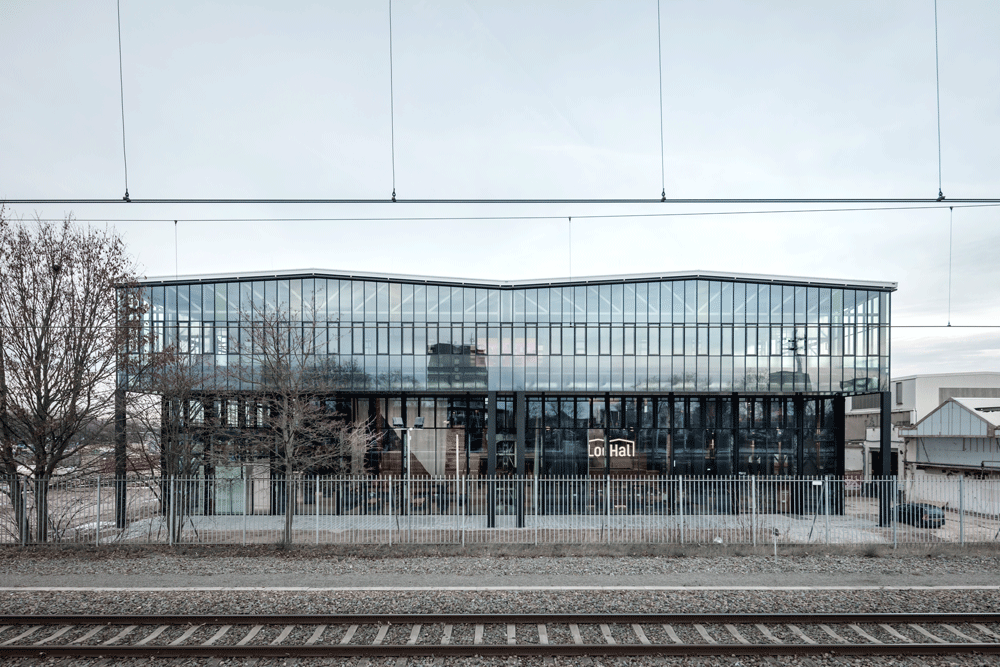Manhattan, New York
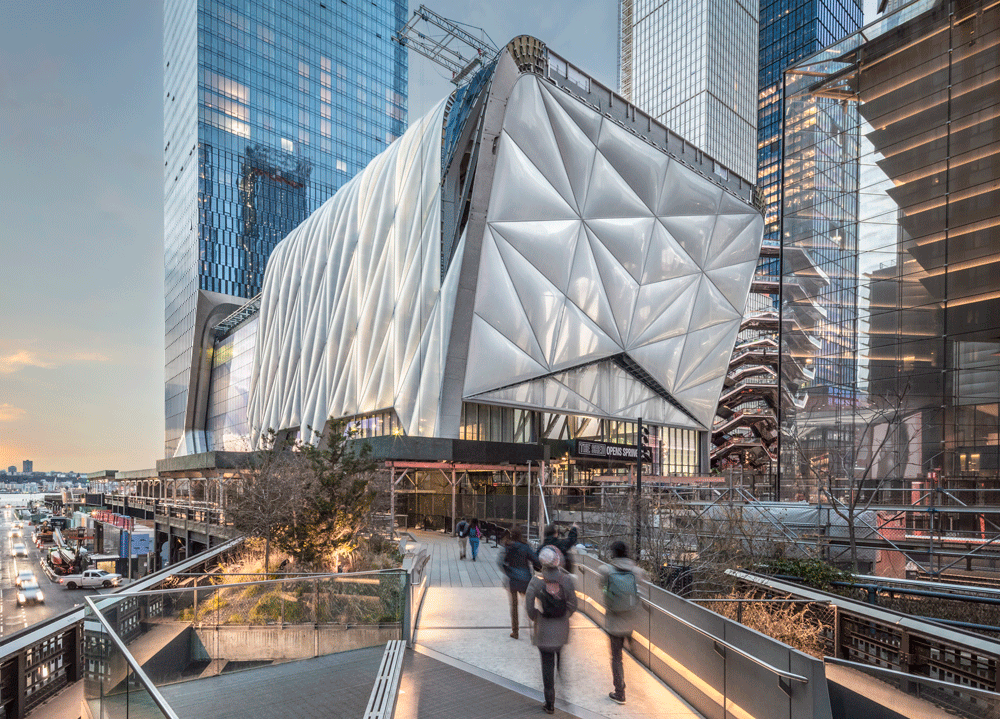
Description and photos below are provided by The Shed
Project Description
Opening in New York in spring 2019, The Shed is dedicated to commissioning, producing, and presenting original works of art, across all disciplines, for all audiences. The Shed’s building—an innovative 200,000-square-foot (18,500 m²) structure designed by Diller Scofidio + Renfro, Lead Architect, and Rockwell Group, Collaborating Architect—is designed to physically transform to support artists’ most ambitious ideas. Its eight-level base building includes two levels of gallery space, a versatile theater, a rehearsal space, a creative lab, and a skylit event space; a telescoping outer shell can deploy from its position over the base building and glide along rails onto an adjoining plaza to double the building’s footprint for large-scale performances, installations, and events.
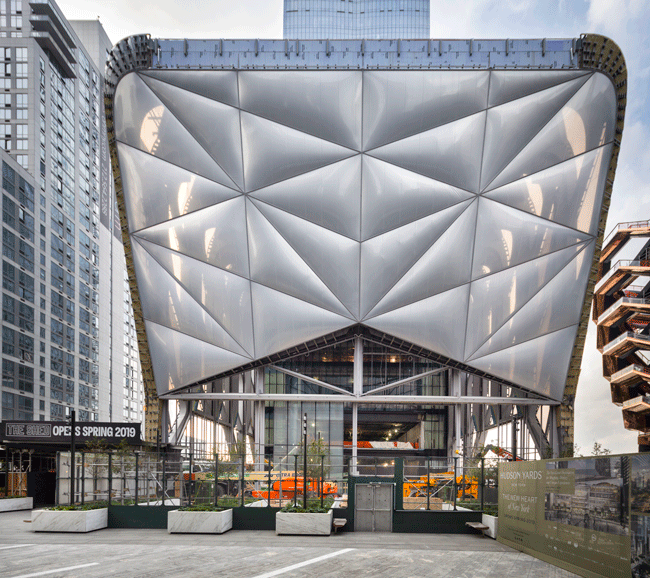
Major Features
The Shed’s open infrastructure can be permanently flexible for an unknowable future and responsive to variability in scale, media, technology, and the evolving needs of artists.
30th Street Lobby (Level 1)
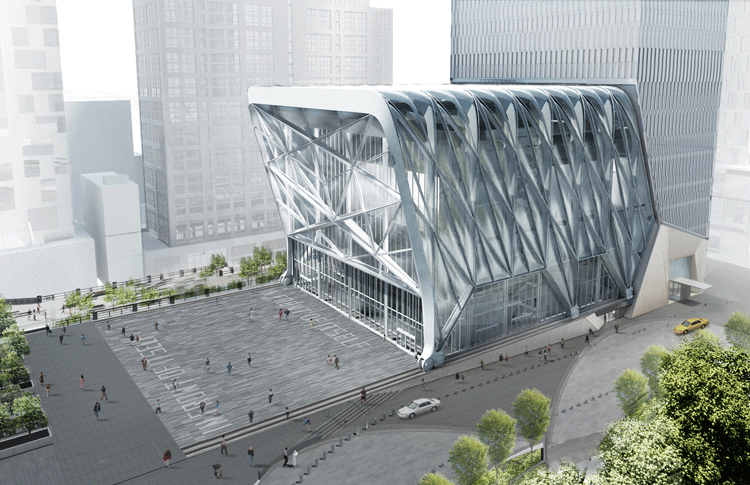
The main entrance to The Shed is on the northside of West 30th Street through an 8,000-square-foot (743 m²) lobby, nestled under the High Line. The lobby features a lounge and ticketing area. Loading docks with two full truck berths and a large freight elevator are located on street level, accessible from 30th Street to the east.
31st Street Entrance (Mezzanine)
The 31st Street entrance will provide convenient access to the 34th Street-Hudson Yards subway station. It features a coat check and provides access to the lobby.
Plaza & The McCourt (Level 2)
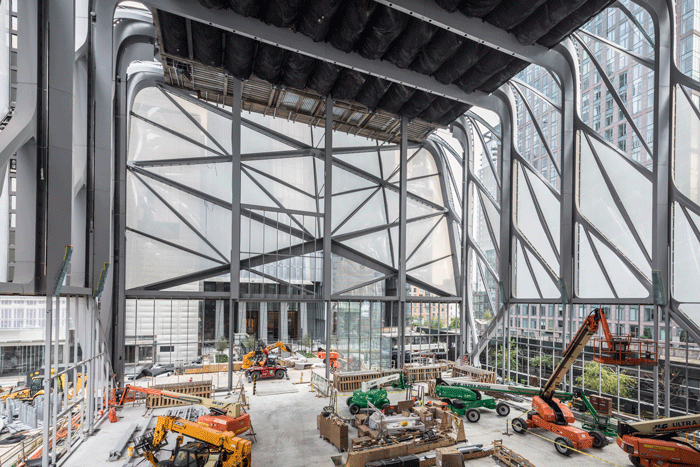
When needed, the telescoping shell can deploy from its nested position over the base building and glide along rails onto the adjoining plaza.
Deployed Shell: When deployed, the shell creates a 17,000-square-foot (1,600 m²), light-, sound- and temperature-controlled space, named The McCourt, that can serve a variety of uses. When The McCourt is combined with the adjacent gallery on Level 2, it creates a nearly 30,000-square-foot (2,715 m²) contiguous space (for reference, Grand Central Terminal’s main concourse is 33,000 square feet). The McCourt can accommodate an audience of 1,250 seated or 2,700 standing; flexible overlap space in the two adjoining galleries of the base building allows for an expanded audience of up to 3,000. The shell’s entire ceiling operates as an occupiable theatrical deck with rigging and structural capacity throughout. Large operable doors on its north and east sides allow The McCourt to function as an open-air pavilion.
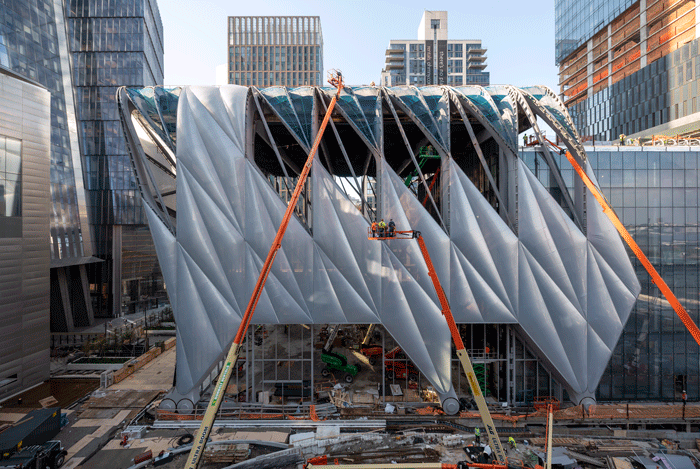
Nested Shell: When the shell is nested over the base building, the 20,000-square-foot (1860 m²) plaza will be open public space that also can be used for outdoor programming; the eastern façade can serve as a backdrop for projection with lighting and sound support. The plaza is equipped with
A large-scale, site-specific work by artist Lawrence Weiner (b. 1942) will be embedded in the plaza, serving as a walkable outdoor area when the shell is nested over the fixed part of the building, or as the base of The McCourt when the shell is extended to the east. The 20,000-square-foot (1860 m²) work is titled IN FRONT OF ITSELF and will feature the phrase in 12-foot-high letters.
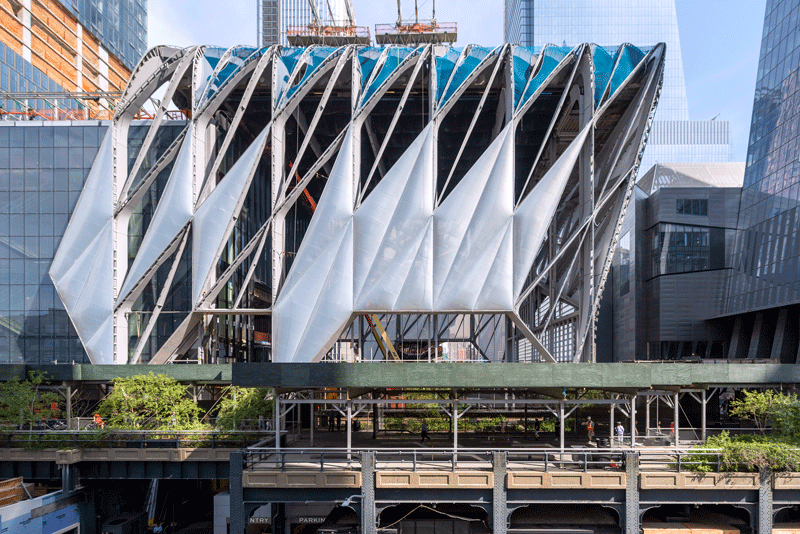
Oversize deliveries can be brought by truck up 31st Street and loaded directly onto the plaza and into the base building or the shell when deployed.
Galleries (Levels 2 & 4)
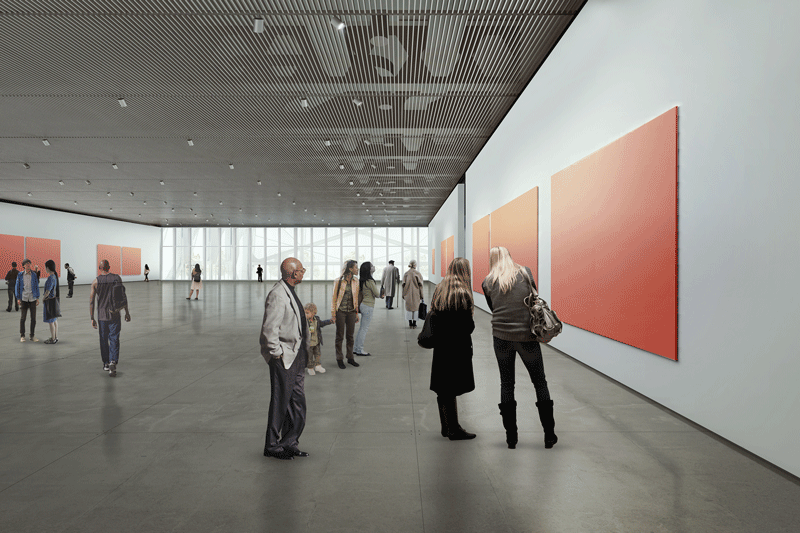
The Shed features two expansive and flexible, column-free galleries on Levels 2 and 4 of the base building, totaling more than 25,000 square feet (2,340 m²) of museum-quality space with 19-foot-high (6 m) ceilings. Operable east-side walls can conjoin the galleries with the deployed shell to accommodate space or seating needs for extra large-scale events.
Theater (Level 6)
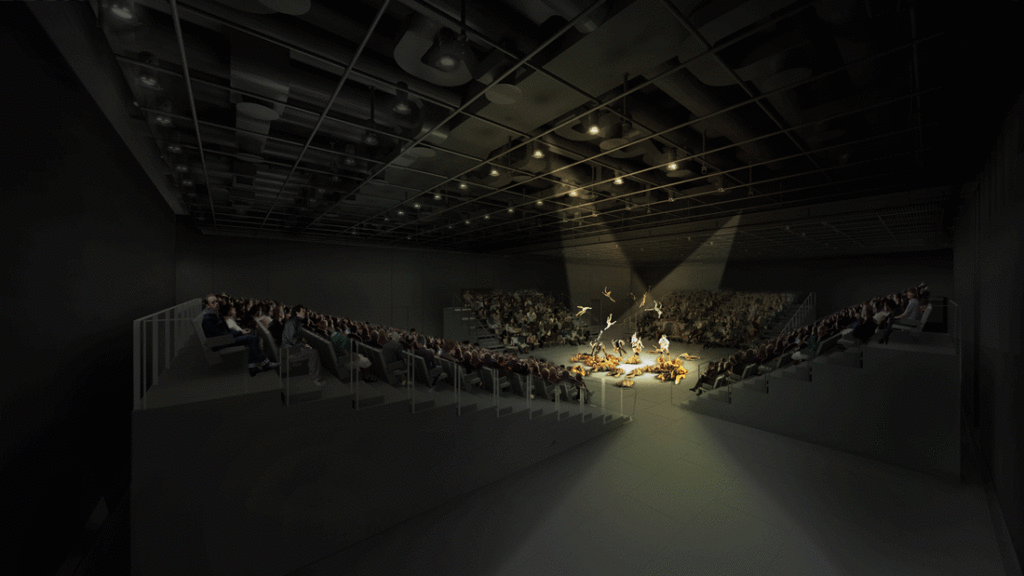
An 11,700-square-foot (1,080 m²), sound-isolated black box space can be used as a single large theater with 500
The Lab, Rehearsal Space, and Event Space (Level 8)
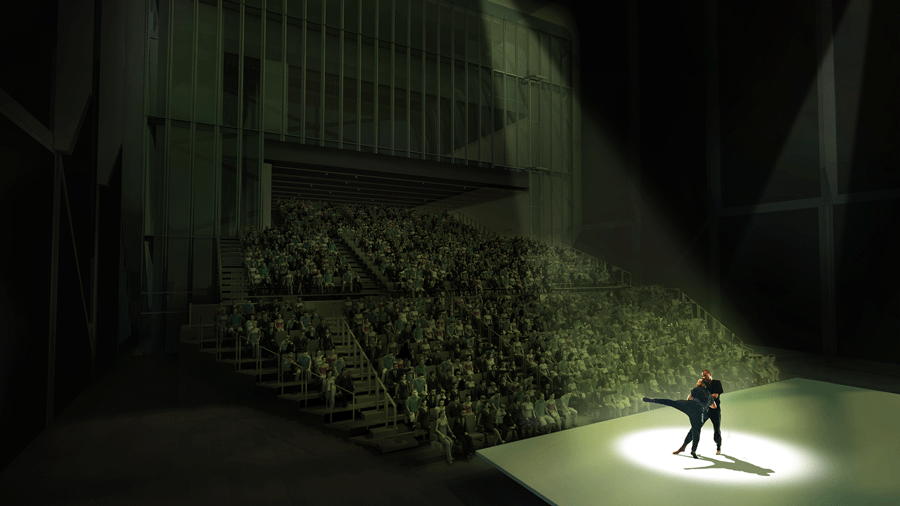
Level 8 features a 1,700-square-foot (160 m²) creative lab for artists, a 3,300-square-foot (305 m²) rehearsal space, and the Event Space, a 9,500-square-foot (880 m²) flexible, multi-purpose space.
Back-of-House (Level 1 and lower levels)
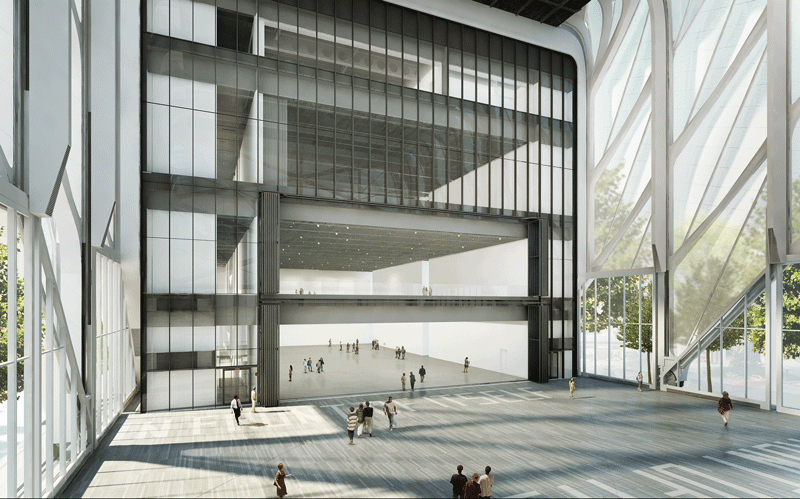
The Shed’s back-of-house spaces, which include offices, mechanical spaces, dressing rooms, and storage, are located on Level 1 and the lower levels of the residential tower to the west, 15 Hudson Yards (also designed by Diller Scofidio + Renfro in collaboration with Rockwell Group). This allows the bulk of The Shed’s base building to be devoted to programmable space for art.
Technical Features
Movable Shell
The Shed’s 120-foot tall (37 m) movable shell is made of an exposed steel diagrid frame, clad in translucent cushions of a strong and lightweight Teflon-based polymer, called ethylene tetrafluoroethylene (ETFE). This material has the thermal properties of insulating glass at a fraction of the weight. The Shed’s ETFE panels are some of the largest ever produced, measuring almost 70 feet (21 m) in length in areas. The Shed has an energy-conscious design: the combination of a radiant heating system within the plaza construction and a variable forced air heating and cooling system serving the occupied portions of the shell for maximum efficiency. The building is designed to achieve LEED Silver certification and to exceed New York’s energy codes by 25%, which is required of all new buildings on city-owned land or using city-provided funds. Despite the shell’s massive two-million-cubic-foot interior, only the lower 30% will need to be temperature controlled. And the plaza will include a radiant-heat floor plate.
Kinetic Elements
The Shed’s kinetic system is inspired by the industrial past of the High Line and the West Side Rail Yard. Based on gantry cranes commonly found in shipping ports and railway systems, the kinetic system comprises a sled drive on top of the base building and bogie wheels guided along a pair of 273-foot-long (83 m) rails onLevel2 (plaza level).
Bogie Wheels: The movable shell rests on six large bogie wheel assemblies; four single-axle and two double-axle bogies. The bogie wheels measure six feet in diameter and are made of hardened forged steel. The weight of the shell is spread across the
Motors: The sled drive, on the roof of the base building, is a rack-and-pinion system with twelve 15-horsepower motors, for a total of 180 horsepower. For comparison, a Toyota Prius develops 134 horsepower. The deployment of the shell takes five minutes at a peak speed of a ¼ mile per hour. The system is run by a secure wireless remote and back-up hardware controls.
Building Materials
Primary materials are structural steel, ETFE, insulated glass, and reinforced concrete
Construction Team
Levien & Company: Owner’s Representative
Sciame Construction, LLC: Construction Manager
Thornton Tomasetti: Structural Design, Façade Engineering and Kinetic Engineering Services
Jaros, Baum & Bolles (JB&B): MEP & Fire Protection Consultant
Hardesty and Hanover: Kinetic Systems Consultant
Vidaris: Energy Modeling Consultant
Tillotson Design Associates: Lighting Consultant
Akustiks: Acoustics / Audio / Visual Consultant Fisher
Dachs: Theater Consultant Cimolai: Structural Steel Fabricator


